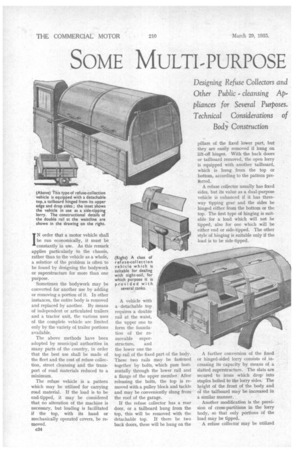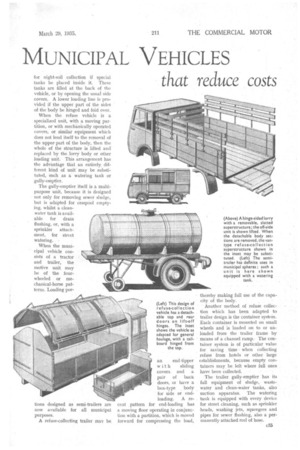SOME MULTI-PURPOSE
Page 88

Page 89

If you've noticed an error in this article please click here to report it so we can fix it.
MUNICIPAL VEHICLES that reduce costs
/N order that a motor vehicle shall be run economically, it must be constantly in use. As this remark applies particularly to the chassis, rather than to the vehicle as a whole, a solution of the problem is often to be found by designing the bodywork or superstructure for more than one purpose.
Sometimes the bodywork may be converted for another use by adding or removing a portion of it. In other instances,_ the entire body is removed and replaced by another. By means of independent or articulated trailers and a tractor unit, the various uses of the complete vehicle are limited only by the variety of trailer portions available.
The above methods have been adopted by municipal authorities in many parts of the country, in order that the best use shall be made of the fleet and the cost of refuse collection, street cleansing and the transport of road materials reduced to a minimum.
The refuse vehicle is a pattern which may be utilized for carrying road material. If the load is to be end-tipped, it may be considered that no alteration of the machine is necessary, but loading is facilitated if the top, with its hand or mechanically operated covers, be removed. A vehicle with a • detachable top requires a double rail at the waist, the upper one to form the foundation of the re movable super structure, and the lower one the top rail of the fixed part of the body. These two rails may be fastened together by bolts, which pass hori zontally through the lower rail and a flange of the upper member. After releasing the bolts, the top is removed with a pulley block and tackle and may be conveniently slung from the roof of the garage.
If the refuse collector has a rear door, or a tailboard hung from the top, this will be removed with the detachable top. If there be two back doors, these will be hung on the pillars of the fixed lower part, but they are easily removed if hung on. lift-off hinges. With the back doors or tailboard removed, the open lorry is equipped with another tailboard, which is hung from the top or bottom, according to the pattern preferred.
A refuse collector usually has fixed sides, but its value as a dual-purpose vehicle is enhanced if it has threeway tipping gear and the sides be hinged either from the bottom or the top. The first type of hinging is suitable for a load which will not be tipped, also for one which will be either end or side-tipped. The other style of hinging is suitable only if the load is to be side-tipped.
A further conversion of the fixed or hinged-sided lorry consists of increasing its capacity by means of a slatted superstructure. The slats are secured to irons which drop into staples bolted to the 'lorry sides. The height of the front of the body and of the tailboard may be increased in a similar manner.
Another modification is the provision of cross-partitions in the lorry body, so that only portions of the load may be tipped.
A refuse collector may be utilized for night-soil collection if special tanks be placed inside it. These tanks are filled at the back of the vehicle, or by opening the usual side covers. A lower loading line is provided if the upper part of the sides of the body be hinged and fold over.
When the refuse vehicle is a specialized unit, with a moving partition, or with mechanically operated covers, or similar equipment which does not lend itself to the removal of the upper part of the body, then the whole of the structure is lifted and replaced by the lorry body or other loading unit. This arrangement has the advantage that an entirely different kind of unitmay be substituted,. such as a watering tank or gully-emptier.
The gully-emptier itself is a multipurpose unit, because it is designed not only for removing sewer sludge, but is adapted for cesspool emptying, whilst a cleanwater tank is available for drain flushing, or, with a sprinkler attachment, for street watering.
When the municipal vehicle consists of a tractor and trailer, the motive unit may be of the fourwheeled or mechanical-horse patterns. Loading per
tions designed as semi-trailers are now available for all municipal purposes.
A refuse-collecting trailer may be
an with end-tipper
sliding covers, and a pair of back doors, or have a box-type body for side or end
loading. A recent pattern for end-loading has a moving floor operating in conjunction with a partition, which is moved forward for compressing the load,
thereby making full use of the capacity of the body.
Another method of refuse collection which has been adapted to• trailer design is the container system. Each container is mounted on small wheels and is loaded on to or unloaded from the trailer frame by means of a channel ramp.The container system is of particular value for 'saving time when collecting refuse from hotels or other large establishments, because empty containers may be left where full ones have been collected.
The trailer gully-emptier has its full equipment of sludge, wastewater and clean-water tanks, also suction apparatus. The watering tank is equipped with every device for street cleaning, such as sprinkler heads, washing jets, squeegees and pipes for sewer flushing, also a permanently attached reel of hose.




































































































































































